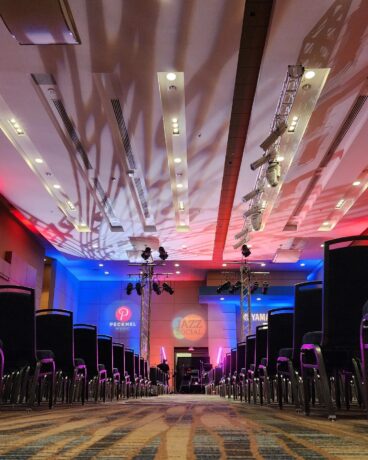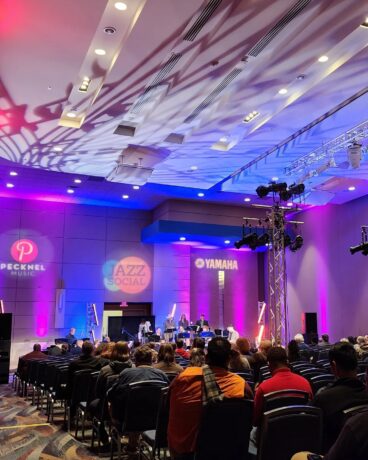 It’s been said that modern art moves to the rhythm of jazz. Anyone who’s appreciated the work of painters like Picasso, Dali, and Jackson Pollock, all inveterate fans of the genre, will readily agree with that. The influence of jazz is felt everywhere on their canvases, from the fearless, unconventional spacing, to the liberating sense of improvisation.
It’s been said that modern art moves to the rhythm of jazz. Anyone who’s appreciated the work of painters like Picasso, Dali, and Jackson Pollock, all inveterate fans of the genre, will readily agree with that. The influence of jazz is felt everywhere on their canvases, from the fearless, unconventional spacing, to the liberating sense of improvisation.
Denise Simpson, who paints when she isn’t creating lighting designs, is keenly aware of this connection. This is why she worked to create “an artistic mood” on stage for the South Carolina Music Educators Association’s Jazz Social at the Columbia Metropolitan Convention Center.
“Given that this event was centered on jazz, I felt it was important to create an artistic look and feel that complimented the performances of the musicians on stage,” said Simpson. “The idea was to bring a moody, evening, neon feel into the room with the set and lighting just upstage of the musicians. With that in mind, for up-tempo pieces I used warm, saturated bright colors, like reds, magentas, and ambers with high points of open white. For playful abstract pieces, I went with magentas, teals, greens, yellows. Then for moody pieces, I used blues, lavenders, teals, with high points of magenta or red. Often each scene was a two-tone look, but also occasionally I used a single full color look or multi tonal look.”
 To conjure up this artistic colorful mix, Simpson, who also programmed the show and designed the set, relied on an ACS Sound & Lighting rig that featured a collection of CHAUVET Professional COLORado and Ovation fixtures. She positioned eight COLORado batten 72 fixtures on four 3-meter truss tours arranged in a semi-circle to add color and depth to the background. Each tower had a pair of battens hung at a slight diagonal angle. She hung the battens at varying heights and at alternating angles to create layers of depth, while also working well to highlight the performers on stage.
To conjure up this artistic colorful mix, Simpson, who also programmed the show and designed the set, relied on an ACS Sound & Lighting rig that featured a collection of CHAUVET Professional COLORado and Ovation fixtures. She positioned eight COLORado batten 72 fixtures on four 3-meter truss tours arranged in a semi-circle to add color and depth to the background. Each tower had a pair of battens hung at a slight diagonal angle. She hung the battens at varying heights and at alternating angles to create layers of depth, while also working well to highlight the performers on stage.
Adding an extra visual touch to the design were gobo patterns of musical notations created with Ovation 3-910FC color-rendering ellipsoidals. Simpson mounted these lights to the set towers on stage and focused them to cover the ceiling above the seating area. The positioning and focus of E-910 FC with gobos on the ceiling coupled with the 24 WELL Fit uplighters positioned throughout the room created a nice ambient light when the architectural lighting was lowered.
“I felt like having the flexibility to surround the room with light really helped bring the audience and musicians together,” said Simpson. “In many cases, I find myself wanting my work to reflect somewhat of an immersive feel. The artistic side of me is hopeful that the people on and off stage experience the event as though they were a part of it. So, whether I am lighting a small show with a limited equipment, limited budget, and strict demands, or a larger scale concert, with complete freedom, I like to think of the people who will be experiencing the event.”
The “workhouse performance” of her COLORado Batten 72 fixtures were essential to helping Simpson achieve her vision. In addition to the eight units flown on the four truss structures, she had six located at various points on the ground, a single unit by the upstage piano, another one behind the drums, two on the top tier of the band riser, one on the upstage edge to light the horn and woodwind section, and the final unit tucked away on the upstage side of the musicians.
“I really wanted to change the feeling of the room from a basic ballroom to have a more artistic look and feel,” said Simpson. Following this approach, her inspired design and the performances on stage made beautiful music together, just as jazz and art always do.
Further information from CHAUVET Professional: www.chauvetprofessional.com


